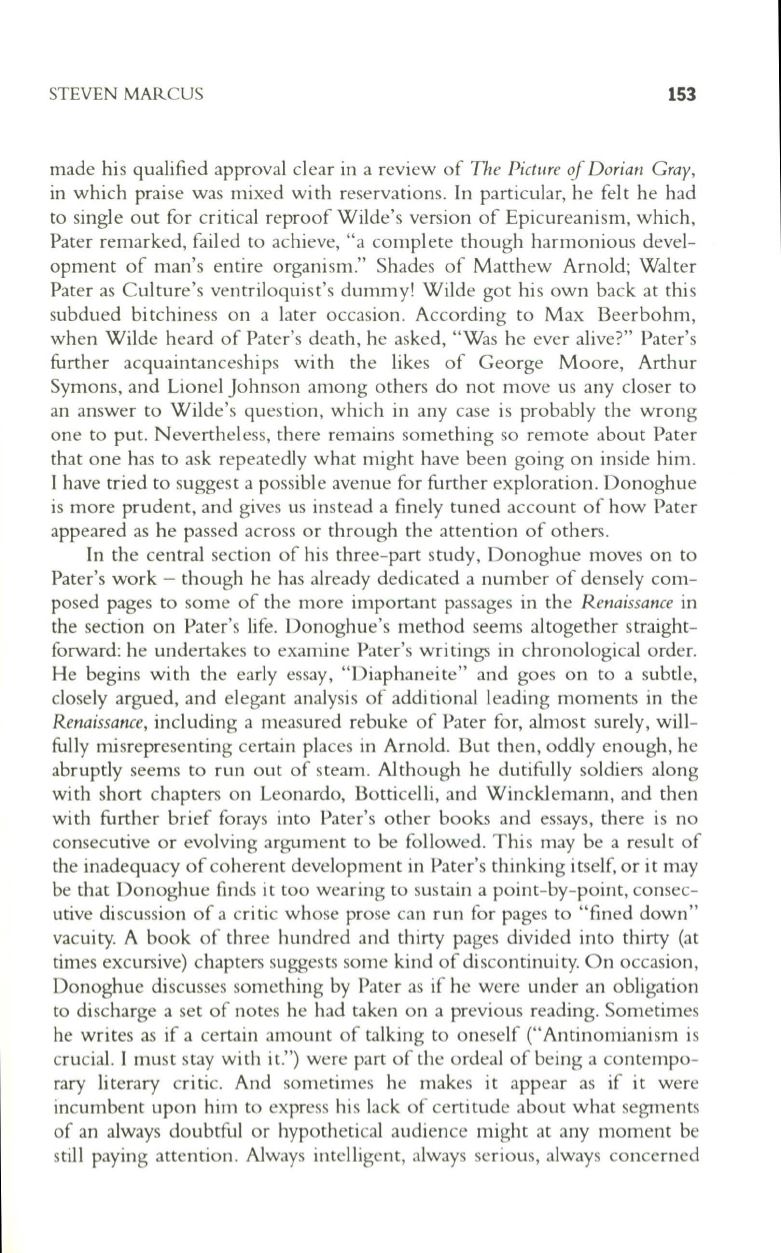
STEVEN MARCUS
153
made his qualified approval clear in a review of
The Picture oj Dorian
Gray,
in which praise was mixed with reservations. In particular, he felt he had
to single out for critical reproof Wilde's version of Epicureanism, which,
Pater remarked, failed to achieve, "a complete though harmonious devel–
opment of man's entire organism." Shades of Matthew Arnold; Walter
Pater as Culture's ventriloquist's dummy! Wilde got his own back at this
subdued bitchiness on a later occasion. According to Max Beerbohm,
when Wilde heard of Pater's death, he asked, "Was he ever alive?" Pater's
further acquaintanceships with the likes of George Moore, Arthur
Symons, and Lionel Johnson among others do not move us any closer to
an answer to Wilde's question, which in any case is probably the wrong
one to put. Nevertheless, there remains something so remote about Pater
that one has to ask repeatedly what might have been going on inside him.
I have tried to suggest a possible avenue for further exploration. Donoghue
is more prudent, and gives us instead a finely tuned account of how Pater
appeared as he passed across or through the attention of others.
In the central section of his three-part study, Donoghue moves on to
Pater's work - though he has already dedicated a number of densely com–
posed pages to some of the more important passages in the
Renaissance
in
the section on Pater's life. Donoghue's method seems altogether straight–
forward: he undertakes to examine Pater's writings in chronological order.
He begins with the early essay, "Diaphaneite" and goes on to a subtle,
closely argued, and elegant analysis of additional leading moments in the
Renaissance,
including a measured rebuke of Pater for, almost surely, will–
fully misrepresenting certain places in Arnold. But then, oddly enough, he
abruptly seems to run out of steam. Although he dutifully soldiers along
with short chapters on Leonardo, Botticelli, and Wincklemann, and then
with further brief forays into Pater's other books and essays, there is no
consecutive or evolving argument to be followed. This may be a result of
the inadequacy of coherent development in Pater's thinking itself, or it may
be that Donoghue finds it too wearing to sustain a point-by-point, consec–
utive discussion of a critic whose prose can run for pages to "fined down"
vacuity. A book of three hundred and thirty pages divided into thirty (at
times excursive) chapters suggests some kind of discontinuity. On occasion,
Donoghue discusses something by Pater as if he were under an obligation
to discharge a set of notes he had taken on a previous reading. Sometimes
he writes as if a certain amount of talking to oneself ("Antinomianism is
crucial. I must stay with it.") were part of the ordeal of being a contempo–
rary literary critic. And sometimes he makes it appear as if it were
incumbent upon him to express his lack of certitude about what segments
of an always doubtful or hypothetical audience might at any moment be
still paying attention. Always intelligent, always serious, always concerned


